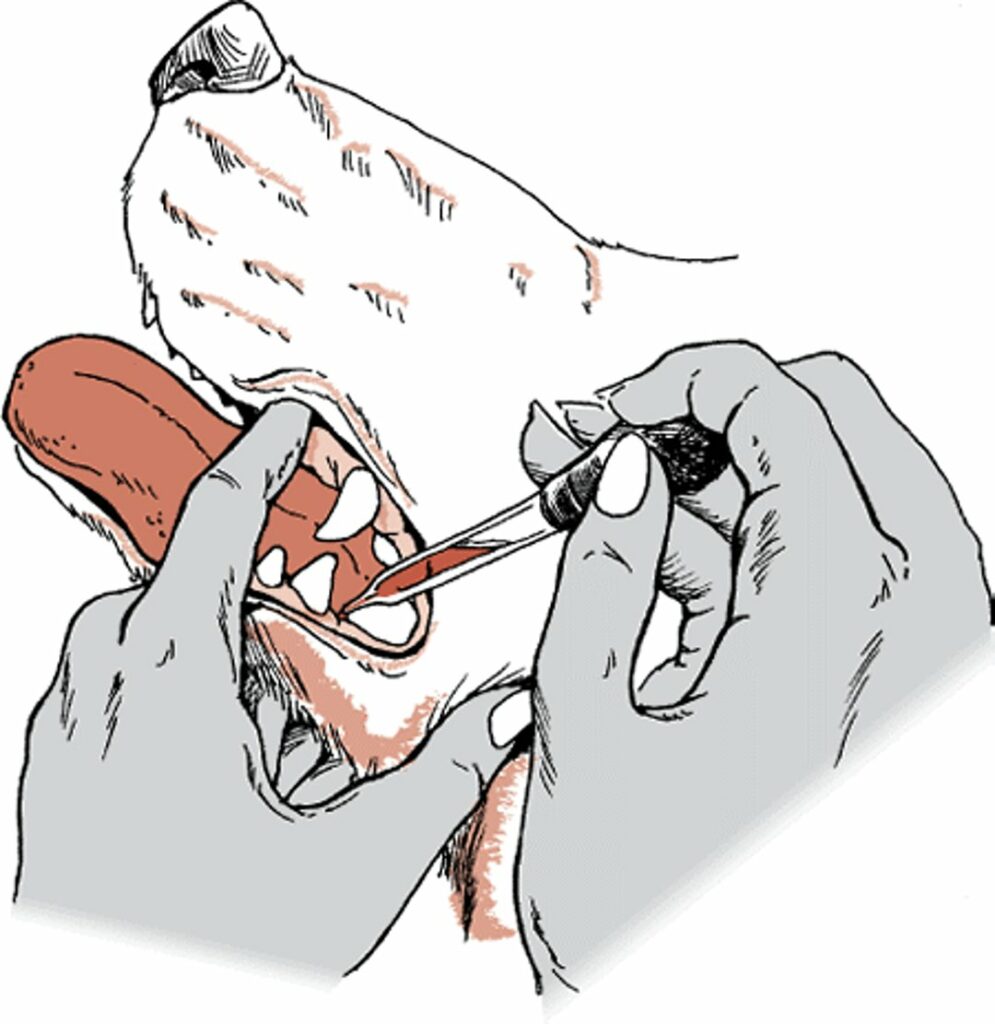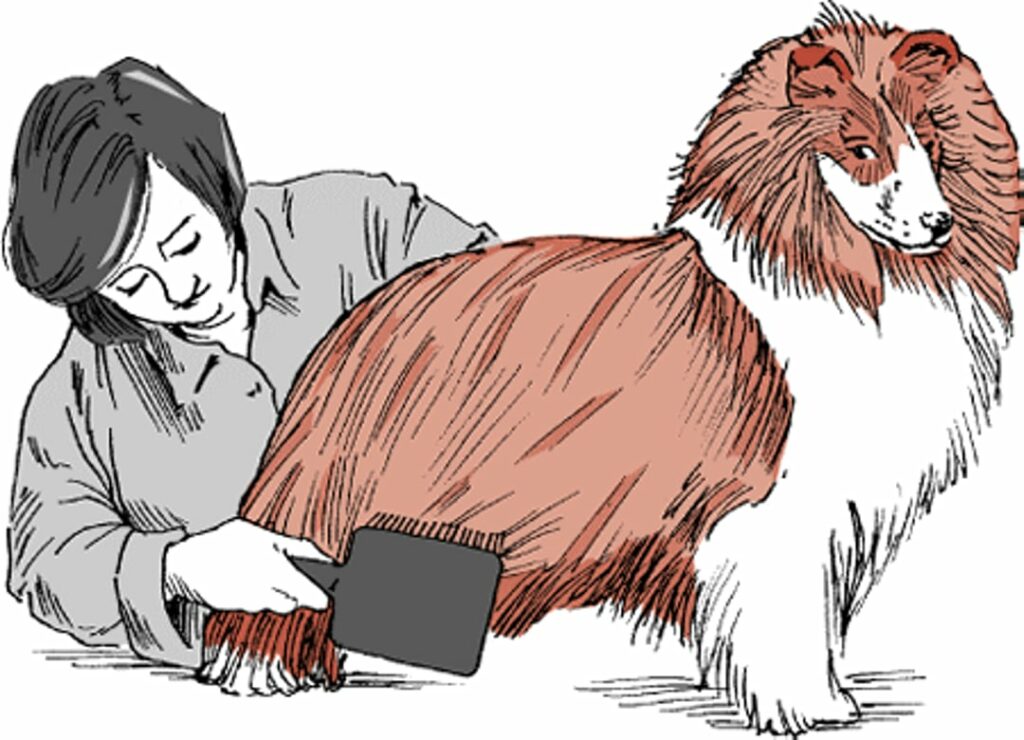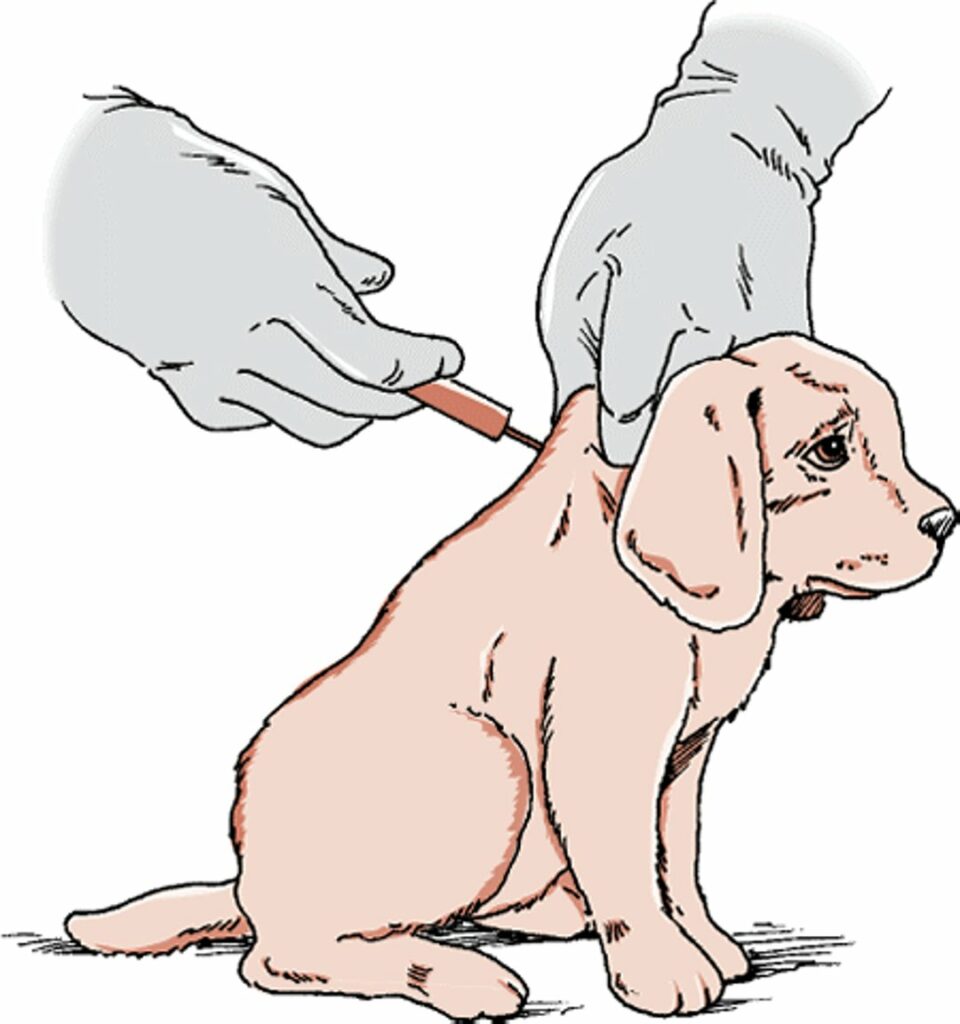In addition to feeding and exercising your dog, other aspects of general care are needed to keep your dog healthy throughout its life. These include routine veterinary care for vaccinations, parasite control, and dental care; grooming; and protection from household hazards.
Importance of Veterinary Care
Adult dogs should have a complete veterinary examination at least once a year. Puppies need veterinary visits usually every 3 to 4 weeks until they are about 4 months old. Geriatric dogs (older than 7 to 8 years old) should see their veterinarian twice a year or more frequently because illness is more common in older pets and it can be identified sooner. Your veterinarian may recommend a wellness program for your pet, including routine blood work to monitor for problems such as early kidney or liver disease.
Signs of Illness
Because you are more familiar with your dog than anyone else, you should watch it carefully for subtle signs of illness that another person or even a veterinarian may miss. General signs of illness include a lack of appetite or decreased activity. Other more specific signs include vomiting and diarrhea, urinating more (or less) frequently, coughing and sneezing, or a discharge from the eyes, ears, or nose. Illness can also show up as a loss of hair or itchy areas on the skin or around the ears. Problems with the musculoskeletal system are often seen as stiffness or lameness, such as not putting weight on a leg. If your dog shows any of these signs for more than a day or two, a visit with your veterinarian is a good idea.
Giving Medication
Pills and chewable medications are usually relatively easy to administer to dogs. Most dogs will readily eat a pill that is hidden in a small treat, such as a piece of cheese or a bit of peanut butter. Sometimes, gently holding the dog’s muzzle closed until you are sure that it has swallowed can be helpful. Liquid medications are sometimes prescribed, particularly for puppies. Liquids can be given via a syringe into the rear of the dog’s mouth by inserting the tip of the syringe near the back teeth on either side. Holding the dog’s head pointing partially upward can help prevent spills. Spot-on products or other topical medications are administered directly on the coat or skin. If your dog needs eye drops or ear medication, your veterinarian or veterinary technician will give you a demonstration. Regardless of the type of medication or how it is to be given, it is important to read and follow all label instructions.
Vaccinations
Administering liquid medicine

Vaccination is a key component of preventive medicine in dogs, just as in people. Vaccinations are given to stimulate the immune system against infection before exposure to a disease. Several vaccines are routinely given to dogs as the core defense against serious infectious illness (for example, distemper, parvovirus, rabies). Several others (referred to as noncore) are important in certain regions and situations (for example, Bordetella, Lyme disease). Your veterinarian can advise which vaccines are necessary in your local area and circumstances.
Traditionally, booster vaccinations have been given every year throughout the dog’s life to ensure ongoing protection. However, the need for yearly revaccination has been questioned in recent years. Some data indicate that after the first year of life, immunity lasts long enough so that booster vaccinations are needed only every few years. However, the debate is ongoing. Your veterinarian will be aware of the most recent findings and can advise you about the best vaccination program for your pet.
Parasite Control
The primary intestinal parasites of dogs include roundworms, hookworms, whipworms, and tapeworms. These worms damage the digestive tract or interfere with absorption of essential nutrients, or both. Intestinal parasite infections are diagnosed by finding worm eggs (or sometimes actual worms or worm segments) in fecal samples. Fecal samples should be tested periodically (yearly or on the schedule recommended by your veterinarian) in all dogs and more frequently in puppies, which are especially prone to parasite infection. These worms usually do not cause intestinal infection in people; however, hookworm infections leading to abdominal pain and inflammation have developed in people with weakened immune systems. Roundworm larvae also have the potential to infect people. When infective roundworm eggs are ingested, they can develop into larvae in the intestine and potentially migrate into sensitive organs. This migration is much more likely to occur in children and people with weakened immune systems. Sanitation is key to prevention because roundworm eggs take about 30 days to become infective; thus, promptly cleaning up feces from your yard can essentially eliminate potential exposure.
Heartworm is an especially serious parasite that is transmitted by mosquito bites. These worms live in the major blood vessels of the lung, causing inflammation of the blood vessels and potentially resulting in heart damage and early death. Because treatment of heartworm infection carries a number of serious health risks and is also potentially fatal, prevention is critical. The Companion Animal Parasite Council, an assembly of experts in veterinary medicine and parasitology, recommend year-round heartworm prevention for dogs, because it is impossible to accurately predict all times when mosquitoes will be present. Additionally, most heartworm preventives contain medications that also treat for intestinal parasites, which can be transmitted at all times of the year. Blood tests to check for heartworm disease should be done yearly.
Common external parasites include fleas, ticks, and mange mites. Monthly preventive treatments are available to control fleas and ticks, and are administered as body sprays or “spot-on” preparations that are placed on the skin between the shoulder blades. Mange mites can be detected by scraping the skin of infected areas for signs of mites or their eggs. Signs of mange include red, scaly areas or bald patches on the skin, or both.
Dental Care
Dogs need dental attention throughout their lives. You can help keep your dog’s teeth and gums in good condition by feeding dry food, providing certain toys (for example, “flossie”-style bones), brushing your dog’s teeth regularly, and following a program of professional dental cleanings and oral care performed by your veterinarian. Good dental care reduces the development of plaque which, if untreated, can progress to gingivitis and periodontal disease. In severe cases of dental disease, extraction is common.
Grooming
Your dog’s hair coat should be brushed regularly to remove shed hair and prevent hair mats. Grooming is especially important for dogs with thick or shaggy hair coats that mat or tangle easily. Mats can irritate the skin, and the moist, stuffy conditions underneath them leaves the skin more susceptible to bacterial or parasite infections. Mats should be removed with electric clippers (not scissors) to avoid cutting the skin underneath. Periodic bathing with a pet shampoo is also important for maintaining healthy skin and fur. However, excessive bathing can irritate and dry the skin and hair. On average, most dogs do not need to be bathed more than once a month, depending on time of year and weather conditions.
Household Hazards
Long haired dog

Your dog must be protected from household hazards, including chemicals, pesticides, cleaning supplies, antifreeze, electrical cords, drugs, alcohol, and poisonous plants. Curious puppies that tend to investigate and chew everything are at greatest risk; however, these products must be kept out of reach of all dogs. Dangerous items (especially electrical cords) can be frequently coated with a foul-tasting spray to discourage chewing. Elements of house design, such as steep stairs, slippery floors, and open windows also pose potential hazards for pets (and people) and should be corrected as much as possible.
Spaying/Neutering
All dogs should be spayed or neutered unless they are to be used for breeding. This prevents unwanted puppies and avoids potentially serious future medical problems, such as prostate disease in males, and uterine infection or mammary cancer in females. Spaying and neutering can also improve behavior. Females are usually spayed around 6 months of age, before their first heat cycle. Allowing a female to go through a heat or to have a litter is not necessary. In fact, the surgery is safest and the future medical benefits are greatest when it is done before the first heat, or estrus, has started. Males are usually neutered between 5 and 10 months of age, depending on breed and size.
PET OWNER VERSION
Breeding and Reproduction of Dogs
The reproductive cycle in female dogs has 4 phases. Female dogs that have not been spayed (bitches) typically have 2 estrus or “heat” periods per year (about 6 months apart), each lasting about 2 to 3 weeks. In some dogs, the intervals between estrus are much longer. The first heat occurs between 6 and 15 months of age, depending on the size of the dog (later in larger breeds). Females can become pregnant during their first heat or any later heat period.
Estrous (Heat) Cycle in Female Dogs
| Proestrus—Start of heat. Lasts 7 to 10 days. Vulva swells and blood flows. Females attract males but will not allow mounting.Estrus—Mating period. Lasts 5 to 10 days. Blood flow lessens and then stops. Females attract and accept males. Ovulation occurs during this time, usually 2 to 3 days after mating.Diestrus. The period 10 to 140 days after heat, when the dog is either pregnant or in a resting phase.Anestrus. The resting period between diestrus and the next heat cycle. |
PET OWNER VERSION
Puppy Care
Importance of Veterinary Care
Just like people, dogs receive a certain degree of immunity (known as maternal immunity) that is passed from their mothers at birth and also shortly thereafter through her milk. Vaccinations cannot effectively stimulate the puppy’s immune system until this maternal immunity wears off. Because maternal immunity declines slowly over time, puppies should be vaccinated every 2 to 3 weeks until they are about 4 months old. This ensures that the puppy receives an effective dose of vaccine soon after maternal protection is gone. Restricting access to unvaccinated dogs until the full series of vaccinations has been given is important to avoid disease.
Puppy vaccination

Intestinal parasites are most common in puppies. Larvae are often passed through the placenta or mother’s milk. Worms are so common that new puppies are often treated with a broad-spectrum wormer as a routine preventive measure. Fecal examinations, with additional treatments as necessary, are usually done every 2 to 4 weeks, until 2 successive fecal examinations are negative.
Diet
Proper nutrition is important throughout a dog’s life and is especially critical during puppyhood. It is difficult for growing puppies to take in enough calories, fat, protein, vitamins, and minerals to meet their needs for rapid growth and development. Puppies need multiple daily feedings of a specially formulated puppy food. The number of daily feedings can be gradually decreased as the puppy ages, but feeding with a name-brand puppy diet should continue until adulthood, which is about 9 to 12 months in most dogs but up to 2 years in giant breeds ( see Table: Feeding Schedule for Dogs).
Socialization and Training
The earliest training that your puppy must learn is housetraining. With patience, persistence, and consistency, housetraining usually takes only a few weeks. The key is to take the puppy outdoors at the times that dogs naturally eliminate and to praise them enthusiastically when they do. Establishing a designated area that the puppy can associate with elimination can be helpful. If accidents happen, take your pet outside to the designated elimination area and praise it for eliminating (if it does so). Punishment, such as rubbing a dog’s nose in urine or feces, does no good and can even have a negative effect on training. Each accident indoors sets the process back a little, so the fewer accidents, the better.
Times When Puppies Naturally Eliminate
| First thing in the morningLast thing at nightAfter each mealAfter drinking a lot of waterAfter waking from a napDuring or after rough play or other activityOn waking during the night (generally only very young puppies) |
All dogs should learn to pay attention and respond to everyone in the household. Teaching young dogs basic obedience commands, including sit, stay, down, come, and heel, increases the control that you have over your dog, which can prevent potentially dangerous situations (such as running away or running into the street). Dogs have an early socialization period, lasting from roughly 2 to 4 months of age. During this time, they more easily learn to accept new people, places, animals, and other experiences. Giving your puppy positive experience with new events during this period can help reduce the chances of fearful behavior and other problems later in life.
Many good books are available on raising and training puppies. In addition, many local trainers, kennels, and community services offer socialization and obedience classes. Socialization classes can begin as early as 8 weeks of age, with obedience classes generally starting at 4 to 6 months of age. In general, obedience training is an activity that you and your dog learn together. The trainer teaches you, and you teach your dog. It takes only a few hours per week, is generally fun for both you and your pet, and can establish good behavior and a strong family bond for the life of your dog.
